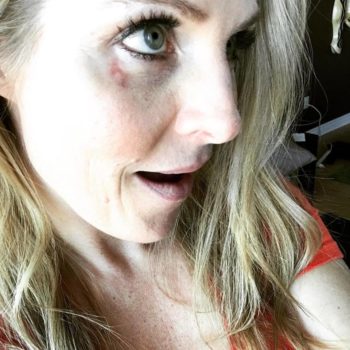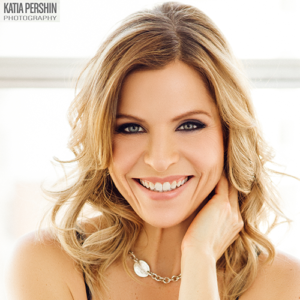A few weeks ago, I shared about my experience with skin cancer. I had a mole (and the “margins”) on my back removed over a decade ago that contained pre-melanoma cells. Then, in January, I had two basal cell carcinomas removed from below my right eye. The surgery should have been “no big deal”. But my body rejected the dissolvable sutures, which extended my healing time. To make matters worse, my surgeon left for a month on vacation right after my surgery, so we weren’t able to course-correct as we could have if he’d been in town.
After 8 weeks of healing, I went in to see him last week and although my wounds have healed, my surgeon took one look and shared that on a scale of 1-10 (with 1 being the worst outcome and 10 being the best), he gives my outcome a measly ONE. He would like me to consider a second surgery in order to improve the appearance of my scar. I am taking his opinion seriously, but I am holding off on a second surgery for now. I have learned a LOT in the process of healing; mostly as it relates to my ego around my appearance but also in the way this experience has inspired me to take my health even more seriously; to prioritize it even more highly in as many ways as possible. And so, I will allow more healing to happen and I will reevaluate in a few months.
Because I believe that it’s all a lesson…

Speaking of lessons, I wanted to share what I've learned about skin cancer, tanning, the sun and sunscreen. If this helps even one person to make more informed decisions, then it will have been worth taking the time to share. So, let's get started.
We'll begin with skin cancer and go from there...
Basal cell carcinoma is the most common--and treatable--form of skin cancer, so while it's not life-threatening, it needs to be monitored by your dermatologist and removed when they deem it necessary. Most tumours arise in areas hit by the sun, so the face is a common spot. Tumours left on the face can become disfiguring, so be sure to have any suspicious spots looked at by a professional.
If you've also experienced a skin cancer, know that we are in good company. My beloved Roger had a tumour removed on his eyebrow last year, several of you have reached out to share your own experiences with basal cell (and other skin cancers), and celebrities like Khloe Kardashian and Hugh Jackman and are quite public about their experiences with it, in an effort to educate people about the dangers of the sun and the importance of having moles and spots checked regularly. In case you're curious, here is a list of celebrities who have gone public with their experiences with skin cancer.
According to the Skin Cancer Foundation:
- About 90 percent of nonmelanoma skin cancers are associated with exposure to ultraviolet (UV) radiation from the sun.
- Basal cell carcinoma (BCC) is the most common form of skin cancer. An estimated 4.3 million cases of BCC are diagnosed in the U.S. each year, resulting in more than 3,000 deaths.
- Squamous cell carcinoma (SCC) is the second most common form of skin cancer. More than 1 million cases of SCC are diagnosed in the U.S. each year, resulting in more than 15,000 deaths.
- An estimated 192,310 cases of melanoma will be diagnosed in the U.S. in 2019.
- An estimated 7,230 people will die of melanoma in 2019. Of those, 4,740 will be men and 2,490 will be women.
- The vast majority of melanomas are caused by the sun. In fact, one UK study found that about 86 percent of melanomas can be attributed to exposure to ultraviolet (UV) radiation from the sun.
- On average, a person’s risk for melanoma doubles if he or she has had more than five sunburns.
- Ultraviolet (UV) radiation is a proven human carcinogen.
- The International Agency for Research on Cancer, an affiliate of the World Health Organization, includes ultraviolet (UV) tanning devices in its Group 1, a list of agents that are cancer-causing to humans. Group 1 also includes agents such as plutonium, cigarettes and solar UV radiation.
- Brazil and Australia have banned indoor tanning altogether. Austria, Belgium, Finland, France, Germany, Iceland, Italy, Norway, Portugal, Spain and the United Kingdom have banned indoor tanning for people younger than age 18.
- More people develop skin cancer because of indoor tanning than develop lung cancer because of smoking.
- Any history of indoor tanning increases the risk of developing basal cell carcinoma before age 40 by 69 percent.
- Women who have ever tanned indoors are six times more likely to be diagnosed with melanoma in their 20s than those who have never tanned indoors. At all ages, the more women tan indoors, the higher their risk of developing melanoma.
- Individuals who have used tanning beds 10 or more times in their lives have a 34 percent increased risk of developing melanoma compared with those who have never used tanning beds.
- People who first use a tanning bed before age 35 increase their risk for melanoma by 75 percent.
I met with Dr. Denis Dudley, founder of The Sunscreen Company (CyberDERM) to ask him to help me understand this issue better. He is a man with a LOT of facts and figures to share, having been at this work for almost 30 years. To learn more, I encourage you to visit Dr. Dudley's blog. During my conversation with him, he confirmed the statistic that those who first use a tanning bed before age 35 increase their risk for melanoma (the deadliest form of skin cancer) by 75 percent and he explained that in just ONE tanning bed session, a user's risk of developing squamous cell carcinoma increases by 67% and basal cell carcinoma by 29%. That floored me!
That was me.
I used tanning beds about once a week in the colder months in my late teens and early twenties for about 2 years and had a mole removed that would have turned into melanoma if it had been left. And now, I am dealing with the effects of having two basal cell tumours removed from my face. I look back now and realize the harm I was doing to my health, and have made it a priority to take precautions to better protect my skin as I continue to age.
I wanted to know more about the effects of the sun and if there was any amount of sun exposure I could safely enjoy. I mean, we've all heard about the benefits of vitamin D and how we get it from the sun. I have loads of people close to me who suggest getting 15-20 minutes of unprotected sun exposure daily to synthesize vitamin D, and I've also got people near me who suggest staying out of the sun and simply eating our D (in the form of fatty fish, eggs and fortified dairy) as well as supplementing with it.
So, what gives?
Dr. Dudley shared with me his view that if we want to protect ourselves from all types of skin cancer, then there is no safe amount of unprotected sun exposure, especially for those of us with fair skin (like me). The Skin Cancer Foundation supports his view where, "The Foundation cautions the public against intentional exposure to natural sunlight or artificial UV radiation (tanning beds) as a means of obtaining vitamin D, since the health risks of UV exposure - including skin cancer and premature skin aging - are significant and well proven."
The bottom line? Dudley suggests we have our blood work done to determine our level of deficiency (most North Americans are) and to supplement. rather than using the sun to boost our levels. I suggest a quality liquid form of vitamin D found at your local health food store or else you may be interested in IV supplementation with a reputable Naturopathic doctor. In Ottawa, I recommend Dr. Sarah Vadeboncoeur and the folks at NutriChem.
As far as sun protection goes, we need to protect our skin through lifestyle strategies like staying in the shade especially during peak sunlight hours (10 am to 4 pm), wearing protective clothing, hats and glasses and if we do choose to spend time outside, the overwhelming recommendation among dermatologists is to to wear sunscreen. But before you reach for that coconut-smelling popular brand you've been using for years, you will want to learn the truth about sunscreen. Personal care companies have capitalized on the public's fear of skin cancer and have pumped out myriad brands of sunscreen since the 1950's, all purporting to protect our precious skin from harmful UV radiation. But are they offering up false confidence instead of real protection? And what is the impact of sunscreen on our environment? And, what about certain ingredients used to formulate it that harm our health and may even cause cancer? Again, my conversation with Dr. Dudley revealed some inconvenient truths about sunscreen, which we'll explore next.
The Truth About Sunscreen

Dr. Dudley first became interested in sunscreen when he was practicing as an OBGyn and endocrinologist. When one of his patients asked if there was a sunscreen she could use that wouldn't harm her growing fetus, he realized he didn't know. But he wanted to learn. And therein lay the impetus for his exhaustive research on the topic that resulted in him creating, The Sunscreen Company.
What I learned during my conversation with him was the reality that up to 90% of sunscreens on the market are toxic not only to humans but also to our marine ecosystem. Studies on coral reefs have shown serious damage and destruction due to the introduction of benzophenone (often shown as oxybenzone on labels), an organic chemical used in printing and plastics that is widely used in personal care products including many commercial sunscreens.
According to a 2008 CDC study, benzophenone (oxybenzone) was found in 97% of Americans tested (both genders), between the ages of 6 and 70. It is still used in 65% of sunscreens in North America and in over 950 cosmetics, which may explain why it is so pervasive.
In 2018, Hawaiian Governor David Ige signed the first bill in the country that will ban sunscreens containing chemicals harmful to coral reefs. According to this article, "A study by Haereticus Environmental Laboratory, a nonprofit scientific organization, found the chemicals cause bleaching, deformities, DNA damage and ultimately death in coral when they're washed off beachgoers or discharged into wastewater treatment plants and deposited into bodies of water."
Whenever I read things like that, I have to ask myself, "If it is that harmful to our coral reefs, what are these ingredients doing to my own health?" Dudley explained to me that soluble filters enter the blood through the skin and are known to be estrogenic hormone disrupters and carcinogens.These chemicals likely represent the single most important source of human exposure to hormone disruptors and present a clear and present danger to the reproductive and other endocrine systems. Dudley went on to explain, "reproductive system problems linked to hormone disruptors range from infertility, polycystic ovarian syndrome, endometriosis, fibroids, breast and uterine cancer, prostate cancer, oligospermia (low sperm count) and male infertility. Non-reproductive disorders include ADHD and autism spectrum disorders, asthma, Parkinson’s disease, Alzheimer’s and thyroid cancer."
To add insult to injury, the sunscreen most often found on store shelves is "UVB biased", meaning, it doesn't protect against harmful and skin-aging UVA radiation (research is now showing that UVA rays can also cause skin cancer), giving us a false sense of security while simultaneously negatively impacting our endocrine system (and harming our oceans). UVB-biased sunscreens typically use soluble filters that include:
- Benzophenone (Oxybenzone)
- avobenzone
- homosalate
- octisalate
- octocrylene
- octinoxate
Dudley's advice, which aligns with recommendations from other skin cancer experts, is that we seek out a safer alternative, which would be a particle-based insoluble filter such as zinc oxide, encapsulated octinoxate, titanium dioxide, Tinosorb S or Tinosorb M. They are safer because they never enter the body and have no risks to human health or the health of the environment and they provide balanced UVB/UVA protection (known as "broad spectrum"). Dudley and his team suggest daily use of a mineral-based sunscreen to lower our risk of photoaging (wrinkles, brown spots, freckles, liver spots, facial spider veins, loss of skin tone in sun-exposed areas and sun-related keratoses, to name a few) and skin cancer.
He reminded me that we really can't rely on labels in North America. SPF values can end up offering only 10-20% of their labelled SPF when measured in actual sunlight (versus the lights in the lab) and the Environmental Working Group (EWG) assessed over 1,800 sunscreens and found that 90% had little or no UVA-1 protection, despite a "broad spectrum" label claim.
The bottom line? Currently in North America, there is a very limited number of filters that provide complete and balanced UVA/UVB protection, which do not enter the body, and are not endocrine disruptors and carcinogens. Zinc oxide is the single best and safest broad spectrum UV filter available because it is better at preventing skin cancer and aging while also protecting our endocrine system and the health of the coral reef. Dudley recommends that rather than choosing a UVB-biased sunscreen with SPF 100 that will afford minimal UVA protection, look for a formulation with either zinc oxide at 20% or more or else zinc oxide at 15% or more along with an encapsulated second filter (like encapsulated octinoxate).
The challenge is to find a sunscreen that protects our skin, our health and the health of our oceans while also being aesthetically pleasing (texture, smell, and the white cast that tends to remain on the skin after using zinc). CyberDERM has achieved this lofty goal with their products, and I am in LOVE with their "Every Morning Sun Whip" with 15% zinc oxide and 7.5% encapsulated octinoxate, SPF 25. It works perfectly under makeup or alone and according to the company, "Looking at actual absorption curves, ours stops almost twice the UV radiation at virtually every wavelength. The consumer never sees absorption curves. Just look for zinc oxide levels greater than 15%." You might find it useful to visit the Environmental Working Group (EWG) to find their list of safer sunscreens and to search your current brand.
The Bottom Line
Our skin is our largest organ and it must be treated with the dignity and respect it deserves.While there is nothing I can do about the damage I caused it as a child, teen and young adult, as Maya Angelou reminds me, now that I know better, I can do better. I have become vigilant when it comes to the products I use and I am heeding Dr. Dudley's advice and will no longer spend time in the sun without being properly protected. As he says, "We pay the price of tanning with skin cancer".
I paid that price, and although I wish I weren't part of the statistic, my experience has inspired me to learn more about my health. And although I have prioritized my skin health for over a decade by avoiding tanning beds, reducing sun exposure, wearing protective clothing (just ask my friends about my obsession with hats and sunglasses!) and broad spectrum sunscreen, I am always seeking to learn more. And I love sharing what I learn with you so that YOU can make the decisions that feel right for you.
In my personal care products and sunscreen, I'll ensure the ingredients are safe for me and the environment.
I hope this article helps you to make more informed decisions when it comes to the sun, protecting yourself from skin cancer and aging, and seeking out safe sunscreen for you and your family. I appreciate Dr. Dudley's time for meeting with me to discuss this topic and for sharing so much with me so that I could help spread the word to you.
Because once we know, we can't un-know.
And because I want you to love your life one bite at a time.
P.S. Here are some more resources for you to check out regarding skin cancer, tanning and sunscreen:
SkinCancer.org Facts & Figures
Downloads
P.S. Let’s be friends! I’d love to connect on Facebook , Twitter and Instagram. Plus, if you haven’t already subscribed to my blog, you should! That way, you won’t miss anything. I'd love for you to stay close.











Leave A Response